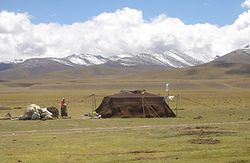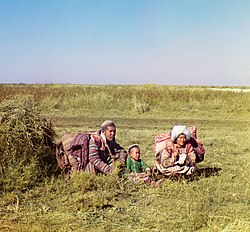Nomad: Difference between revisions
No edit summary |
No edit summary |
||
| Line 10: | Line 10: | ||
Nomadic hunter-gatherers have by far the longest-lived subsistence method in human history, following seasonally available wild plants and game. Pastoralists raise herds and move with them so as not to deplete pasture beyond recovery in any one area. Peripatetic nomads are more common in industrialized nations, traveling from one territory to another and offering a trade wherever they go. |
Nomadic hunter-gatherers have by far the longest-lived subsistence method in human history, following seasonally available wild plants and game. Pastoralists raise herds and move with them so as not to deplete pasture beyond recovery in any one area. Peripatetic nomads are more common in industrialized nations, traveling from one territory to another and offering a trade wherever they go. |
||
Nomadic peoples were often at odds with more advanced economies based on plant agriculture. Expanding populations of farmers tended to push out nomads or hunter gatherers, as the Japanese culture displaced the [[Ezo]]. Likewise, nomads, driven by their powerty, often attacked wealthier settled societies, in places like Europe and Central Asia. Relations could be peaceful in alternating periods. |
|||
== Nomadic hunter-gatherers == |
== Nomadic hunter-gatherers == |
||
Revision as of 02:19, 10 March 2008
This article needs additional citations for verification. (July 2006) |


Nomadic people, also known as nomads, are communities of people that move from one place to another, rather than settling down in one location. There are an estimated 30-40 million nomads in the world.[1] Many cultures have been traditionally nomadic, but traditional nomadic behavior is increasingly rare in industrialized countries. There are three kinds of nomads, hunter-gatherers, pastoral nomads, and peripatetic nomads.
Nomadic hunter-gatherers have by far the longest-lived subsistence method in human history, following seasonally available wild plants and game. Pastoralists raise herds and move with them so as not to deplete pasture beyond recovery in any one area. Peripatetic nomads are more common in industrialized nations, traveling from one territory to another and offering a trade wherever they go.
Nomadic peoples were often at odds with more advanced economies based on plant agriculture. Expanding populations of farmers tended to push out nomads or hunter gatherers, as the Japanese culture displaced the Ezo. Likewise, nomads, driven by their powerty, often attacked wealthier settled societies, in places like Europe and Central Asia. Relations could be peaceful in alternating periods.
Nomadic hunter-gatherers
For more than one million years before domestication[citation needed], nomadic hunter-gatherers (also known as foragers) moved from campsite to campsite, following game and wild fruits and vegetables.
Examples of nomadic hunter-gatherers
- Various groups of Pygmies, such as the Mbuti of the Ituri Rainforest in the Democratic Republic of the Congo
- The Bushmen (also known as Basarwa or San) of southern Africa
- Some prior to Western contact
- Most Indigenous Australians prior to Western contact
- The Negritos of Southeast Asia
- Some Adivasi tribal people of India
Pastoral nomads

- See also nomadic pastoralism
This nomadic pastoralism is thought to have developed in three stages that accompanied population growth and an increase in the complexity of social organization. Karim Sadr has proposed the following stages:
- Pastoralism: This is a mixed economy with a symbiosis within the family.
- Agropastoralism: This is when symbiosis is between segments or clans within an ethnic group.
- True Nomadism: This is when symbiosis is at the regional level, generally between specialized nomadic and agricultural populations.
The pastoralists are sedentary to a certain area as they move between the permanent spring, summer, autumn and winter pastures for their livestock. The nomads moved depending on the availability of their resources.

Origin of nomadic pastoralism
Nomadic pastoralism seems to have developed as a part of the secondary products revolution proposed by Andrew Sherratt, in which early pre-pottery Neolithic cultures that had used animals as live meat ("on the hoof") began also using animals for their secondary products, for example, milk and its associated dairy products, wool and other animal hair, hides and consequently leather, manure for fuel and fertilizer, and traction.
The first nomadic pastoral society developed in the period from 8500-6500 BC in the area of the southern Levant. There, during a period of increasing aridity, PPNB cultures in the Sinai were replaced by a nomadic, pastoral pottery-using culture, which seems to have been a cultural fusion between a newly arrived Mesolithic people from Egypt (the Harifian culture), adopting their nomadic hunting lifestyle to the raising of stock. This lifestyle quickly developed into what Jaris Yurins has called the circum-Arabian nomadic pastoral techno-complex and is possibly associated with the appearance of Semitic languages in the region of the Ancient Near East. The rapid spread of such nomadic pastoralism was typical of such later developments as of the Yamnaya culture of the horse and cattle nomads of the Eurasian steppe, or of the Turko-Mongol spread of the later Middle Ages.
Examples of pastoral nomads

|
|
Traditionally nomadic people in industrialized nations
- Roma (Gypsies)
- Irish Travellers
- Yeniche
- Some Saami communities
One of the consequences of the break-up of the Soviet Union and the subsequent political independence and economic collapse of its Central Asian republics is the resurgence of pastoral nomadism.[citation needed] Taking the Kyrgyz people as a representative example, nomadism was the center of their economy prior to Russian colonization at the turn of the C19/C20, when they were settled into agricultural villages. The population became increasingly urbanized after World War II, but some people continued to take their herds of horses and cows to the high pasture (jailoo) every summer, i.e. a pattern of transhumance. Since the 1990s, as the cash economy shrunk, unemployed relatives were absorbed back on the family farm, and the importance of this form of nomadism has increased. The symbols of nomadism, specifically the crown of the grey felt tent known as the yurt, appears on the national flag, emphasizing the centrality of their nomadic history and past in the creation of the modern nation of Kyrgyzstan.
Nomadism unique to industrialized nations
See also
- Eurasian nomads for the historically and pre-historically important Horse People
- Itinerant
- Kochari
- Transhumance
- Snowbird (people)
- Seasonal human migration
- Uncontacted peoples
References
Mohsen Farsani. Lamentations chez les nomades bakhtiari d'Iran, Paris. 2003.
Further reading
- Sadr, Karim. The Development of Nomadism in Ancient Northeast Africa, University of Pennsylvania Press, 1991. ISBN 0-8122-3066-3
- Cowan, Gregory. "Nomadology in Architecture: Ephemerality, Movement and Collaboration" University of Adelaide 2002 (available: http://hdl.handle.net/2440/37830 [1])
- Chatwin, Bruce. The Songlines (1987)
- Deleuze and Guattari, A Thousand Plateaus (1980)
- Melvyn Goldstein: The Impact of China's Reform Policy on the Nomads of Western Tibet
- The Remote World of Tibet's Nomads
- Grousset, René. L'Empire des Steppes (1939) Template:Fr icon
- Michael Haerdter Remarks on modernity, mobility, nomadism and the arts
- Kradin, Nikolay. Nomadic Empires in Evolutionary Perspective. In Alternatives of Social Evolution. Ed. by N.N. Kradin, A.V. Korotayev, Dmitri Bondarenko, V. de Munck, and P.K. Wason (p. 274-288). Vladivostok: Far Eastern Branch of the Russian Academy of Sciences; reprinted in: The Early State, its Alternatives and Analogues. Ed. by Leonid Grinin et al. (р. 501-524). Volgograd: Uchitel', 2004.
- Kradin, Nikolay N. 2002. Nomadism, Evolution, and World-Systems: Pastoral Societies in Theories of Historical Development. Journal of World-System Research 8: 368-388.
- Kradin, Nikolay N. 2003. Nomadic Empires: Origins, Rise, Decline. In Nomadic Pathways in Social Evolution. Ed. by N.N. Kradin, Dmitri Bondarenko, and T. Barfield (p. 73-87). Moscow: Center for Civilizational Studies, Russian Academy of Sciences.
- Kradin, Nikolay N. 2006. Cultural Complexity of Pastoral Nomads. World Cultures 15: 171-189.
